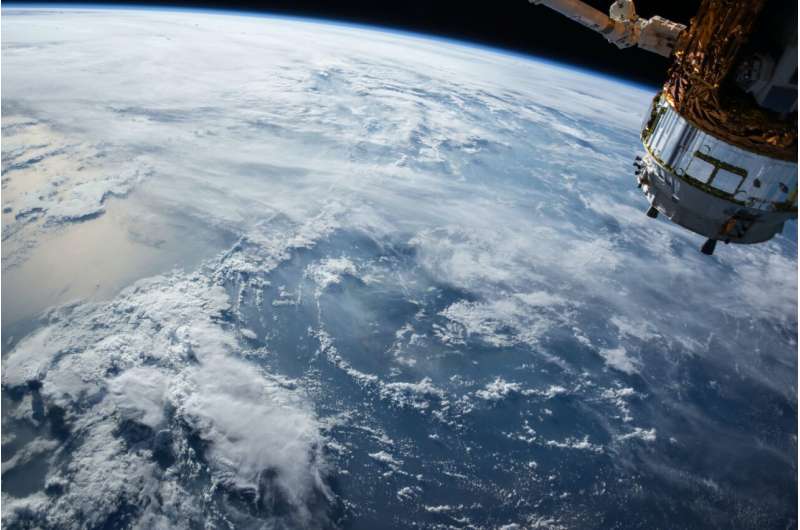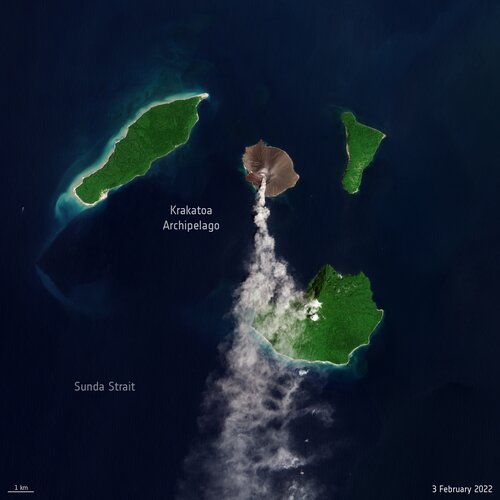
Copernical Team
Video: Webb Quest—mind-blowing mission to the early Universe
Use this form if you have come across a typo, inaccuracy or would like to send an edit request for the content on this page. For general inquiries, please use our contact form. For general feedback, use the public comments section below (please adhere to guidelines).
Please select the most appropriate category to facilitate processing of your request
NASA, NOAA to get new weather eyes in the sky with March launch from Cape Canaveral

Soon, weather scientists will have an even stronger pair of eyes in the sky once a new advanced weather satellite launches this March.
The GOES-T, short for Geostationary Operational Environmental Satellite, is aiming for liftoff March 1 from Cape Canaveral Space Force Station on a United Launch Alliance Atlas V rocket thanks to a collaboration between the National Oceanic and Atmospheric Administration and NASA along with several other partners.
GOES-T, roughly the size of a small school bus, is the third in the GOES-R series of four advanced weather satellites. The value of GOES-T isn't exactly clear as the NOAA doesn't individually price out satellites one by one, said Pam Sullivan director of the GOES-R program. However, Sullivan did say the four-part project costs $11.7 billion.
"The value is returned to us public in benefits provided," Sullivan. "The observations of these satellites is even more critical now that the U.S. is experiencing a record number of billion dollar disasters."
Last year, dry and heated conditions led to an unprecedented amount wildfires in the northwest U.S. with thousands of acres burnt. Both Germany and China experienced historic flooding, and the Atlantic observed 21 named tropical systems—the third highest amount behind 2020′s 30 named storms and 2005′s 27 total.
New eruption at Krakatoa Volcano
 Image:
A new eruption started at the Anak Krakatoa volcano in Indonesia on 3 February 2022, as seen in this image captured by the Copernicus Sentinel-2 mission.
Image:
A new eruption started at the Anak Krakatoa volcano in Indonesia on 3 February 2022, as seen in this image captured by the Copernicus Sentinel-2 mission. Week in images: 31 January - 4 February 2022

Week in images: 31 January - 4 February 2022
Discover our week through the lens
Defence Procurement Minister launches Defence Space Strategy
 It's a huge pleasure to be here today on the next step in our execution of the Integrated Review, the Defence Command Paper and Defence and Security Industrial Strategy.
A lot has happened in Defence in the last year. From assisting in homeland resilience in issues as varied at vaccine delivery to Heavy Goods Vehicle support to the largest Royal Navy deployment in decades making our positi
It's a huge pleasure to be here today on the next step in our execution of the Integrated Review, the Defence Command Paper and Defence and Security Industrial Strategy.
A lot has happened in Defence in the last year. From assisting in homeland resilience in issues as varied at vaccine delivery to Heavy Goods Vehicle support to the largest Royal Navy deployment in decades making our positi SpaceX launches Starlink satellites from Florida
 SpaceX launched 49 of its own Starlink broadband communications satellites from Florida on Thursday afternoon in a mission delayed by over a week.
The Falcon 9 rocket lifted off at 1:13 p.m. EST into a sunny, warm sky from Complex 39A at Kennedy Space Center.
The Starlink launch had been postponed repeatedly as the company dealt with adverse weather and other delays to launch an
SpaceX launched 49 of its own Starlink broadband communications satellites from Florida on Thursday afternoon in a mission delayed by over a week.
The Falcon 9 rocket lifted off at 1:13 p.m. EST into a sunny, warm sky from Complex 39A at Kennedy Space Center.
The Starlink launch had been postponed repeatedly as the company dealt with adverse weather and other delays to launch an Intelsat/SKY Perfect JSAT Corp expand high-throughput inflight connectivity network over Asia
 Intelsat, operator of the world's largest integrated satellite and terrestrial network and leading provider of inflight connectivity (IFC), has expanded its partnership with SKY Perfect JSAT Corporation to use its next-generation JCSAT-1C high-throughput satellites (HTS) over Japan and Asia, one of the fastest-growing markets for air travel. The partnership benefits both airlines and passengers
Intelsat, operator of the world's largest integrated satellite and terrestrial network and leading provider of inflight connectivity (IFC), has expanded its partnership with SKY Perfect JSAT Corporation to use its next-generation JCSAT-1C high-throughput satellites (HTS) over Japan and Asia, one of the fastest-growing markets for air travel. The partnership benefits both airlines and passengers Chandrayaan-3 scheduled for launch in August 2022, Lok Sabha told
 The Department of Space has planned as many as 19 missions this year even as the Chandrayaan-3, the next phase of India's mission to the moon, is scheduled for August 2022, the government told the Lok Sabha.
"Based on the learnings from Chandrayaan-2 and suggestions made by the national level experts, the realisation of Chandrayaan-3 is in progress. Many related hardware and their special
The Department of Space has planned as many as 19 missions this year even as the Chandrayaan-3, the next phase of India's mission to the moon, is scheduled for August 2022, the government told the Lok Sabha.
"Based on the learnings from Chandrayaan-2 and suggestions made by the national level experts, the realisation of Chandrayaan-3 is in progress. Many related hardware and their special Astronaut hits 300 days in space, on way to break NASA record
 NASA astronaut Mark Vande Hei has lived in space continuously for 300 days since launching and docking to the orbiting lab on April 9, 2021. He is on his way to surpassing Christina Koch's 328-day mission on March 3 and Scott Kelly's 340 days on March 15. Vande Hei will return to Earth on March 30 with a NASA astronaut record-breaking 355 consecutive days in Earth orbit.
CAPCOM Woody Hobau
NASA astronaut Mark Vande Hei has lived in space continuously for 300 days since launching and docking to the orbiting lab on April 9, 2021. He is on his way to surpassing Christina Koch's 328-day mission on March 3 and Scott Kelly's 340 days on March 15. Vande Hei will return to Earth on March 30 with a NASA astronaut record-breaking 355 consecutive days in Earth orbit.
CAPCOM Woody Hobau Former NASA official starts company to put robotic spacecraft in orbit
 A former NASA official revealed Thursday that his new space company, Maryland-based Quantum Space, plans to launch robotic satellite outposts to orbit the sun about a million miles from the Earth.
The eventual goal is to provide easier and cheaper access to space while also limiting debris in Earth's orbit, Steve Jurczyk, Quantum CEO, told UPI in an interview.
"We'd have a regular ca
A former NASA official revealed Thursday that his new space company, Maryland-based Quantum Space, plans to launch robotic satellite outposts to orbit the sun about a million miles from the Earth.
The eventual goal is to provide easier and cheaper access to space while also limiting debris in Earth's orbit, Steve Jurczyk, Quantum CEO, told UPI in an interview.
"We'd have a regular ca 